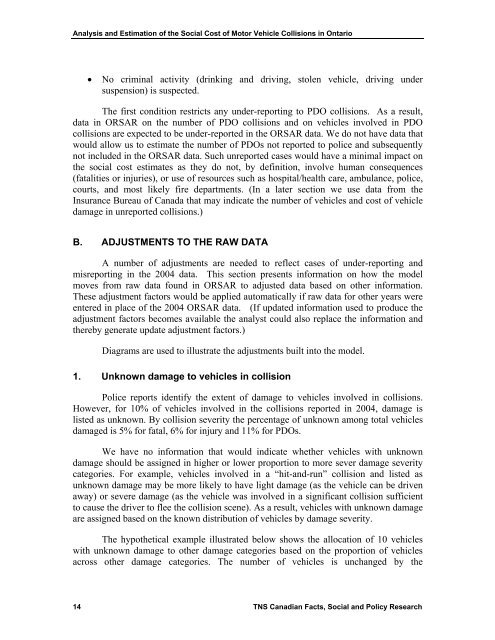Keith Vodden Dr. Douglas Smith - Transports Canada
Keith Vodden Dr. Douglas Smith - Transports Canada
Keith Vodden Dr. Douglas Smith - Transports Canada
You also want an ePaper? Increase the reach of your titles
YUMPU automatically turns print PDFs into web optimized ePapers that Google loves.
Analysis and Estimation of the Social Cost of Motor Vehicle Collisions in Ontario<br />
• No criminal activity (drinking and driving, stolen vehicle, driving under<br />
suspension) is suspected.<br />
The first condition restricts any under-reporting to PDO collisions. As a result,<br />
data in ORSAR on the number of PDO collisions and on vehicles involved in PDO<br />
collisions are expected to be under-reported in the ORSAR data. We do not have data that<br />
would allow us to estimate the number of PDOs not reported to police and subsequently<br />
not included in the ORSAR data. Such unreported cases would have a minimal impact on<br />
the social cost estimates as they do not, by definition, involve human consequences<br />
(fatalities or injuries), or use of resources such as hospital/health care, ambulance, police,<br />
courts, and most likely fire departments. (In a later section we use data from the<br />
Insurance Bureau of <strong>Canada</strong> that may indicate the number of vehicles and cost of vehicle<br />
damage in unreported collisions.)<br />
B. ADJUSTMENTS TO THE RAW DATA<br />
A number of adjustments are needed to reflect cases of under-reporting and<br />
misreporting in the 2004 data. This section presents information on how the model<br />
moves from raw data found in ORSAR to adjusted data based on other information.<br />
These adjustment factors would be applied automatically if raw data for other years were<br />
entered in place of the 2004 ORSAR data. (If updated information used to produce the<br />
adjustment factors becomes available the analyst could also replace the information and<br />
thereby generate update adjustment factors.)<br />
Diagrams are used to illustrate the adjustments built into the model.<br />
1. Unknown damage to vehicles in collision<br />
Police reports identify the extent of damage to vehicles involved in collisions.<br />
However, for 10% of vehicles involved in the collisions reported in 2004, damage is<br />
listed as unknown. By collision severity the percentage of unknown among total vehicles<br />
damaged is 5% for fatal, 6% for injury and 11% for PDOs.<br />
We have no information that would indicate whether vehicles with unknown<br />
damage should be assigned in higher or lower proportion to more sever damage severity<br />
categories. For example, vehicles involved in a “hit-and-run” collision and listed as<br />
unknown damage may be more likely to have light damage (as the vehicle can be driven<br />
away) or severe damage (as the vehicle was involved in a significant collision sufficient<br />
to cause the driver to flee the collision scene). As a result, vehicles with unknown damage<br />
are assigned based on the known distribution of vehicles by damage severity.<br />
The hypothetical example illustrated below shows the allocation of 10 vehicles<br />
with unknown damage to other damage categories based on the proportion of vehicles<br />
across other damage categories. The number of vehicles is unchanged by the<br />
14 TNS Canadian Facts, Social and Policy Research
















